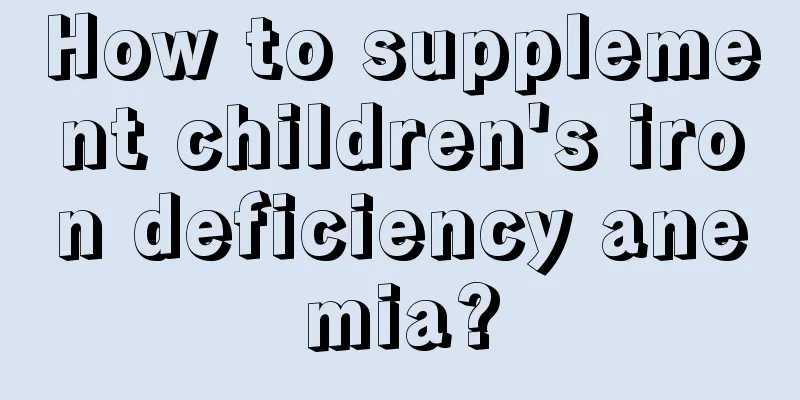Children occasionally have nosebleeds

|
Nosebleeds are not a very strange but not a common phenomenon either. Some people have never had a nosebleed. However, when children are children, parents find that their children occasionally have nosebleeds. This is mainly because the children are too active and easily bumped. The bridge of the child's nose is relatively fragile, and violent impacts can easily cause congestion of the nasal mucosa. Next, if you are sure that your nose is not dislocated, use cotton or paper ball to block it and apply cold compress, and the nosebleed will stop naturally. What causes nosebleed in children? 1. What causes nose bleeding in children? The nasal mucosa of children is fragile when they are young. In dry weather, more blood needs to flow through the nasal cavity to increase the temperature and humidity, which can easily cause congestion of the nasal mucosa and lead to bleeding. 2. It may be caused by trauma. Children are very active and can easily collide or be hit hard while running and jumping, causing their fragile noses to bleed. Putting foreign objects into the nasal cavity while playing can also easily cause nosebleeds. 3. The child picks his nose with his hands. Young children with allergic rhinitis or colds will have itchy noses due to runny nose and nasal congestion, which may cause sneezing or picking their nostrils with their fingers, causing injury and bleeding to the fragile nasal mucosa. 4. The child’s lifestyle is not normal. Many children are prone to nosebleeds due to irregular schedules, less sleep, and weak bodies. Children who suffer nosebleeds due to irregular work and rest schedules usually also have a lot of eye and nasal mucus and bad breath. 5. Congenital allergies cause nasal allergies. It is particularly obvious in winter, and nosebleeds are easily caused by the fragility of the nasal mucosa and the dry cold air in winter. Most babies who are prone to nosebleeds have symptoms of allergic rhinitis, because the nasal mucosa of allergic rhinitis often has erosion symptoms, and they often rub their noses due to itching, causing injury to the nasal mucosa and bleeding. 6. In addition, clinically, some systemic diseases such as abnormal coagulation factors or tumors in the nasal cavity may also manifest as "nosebleeds" in the early stages due to other diseases. If your baby often has nosebleeds for no reason, it may be a sign of certain diseases. You should take him to an ENT doctor to find out the real cause. Some medicines contain anticoagulant properties, which may cause nosebleeds during use. Babies with weak constitutions or those suffering from blood diseases such as leukemia and hemophilia are prone to nosebleeds. Daily care: what to do if your child has a nosebleed 1. Apply cold compress. If a small amount of blood is dripping, parents can use ice bags or wet towels to cool the forehead and neck, or rinse the mouth with cold or ice water to constrict blood vessels and reduce bleeding. 2. Press the nose wings. The specific operation is that parents use their thumb and index finger to pinch the nostrils on both sides for about 10 to 20 minutes (if you are sure which nostril is bleeding, you can directly press the bleeding nostril). Many parents first think of using paper towels to block the bleeding. In fact, the pressure of paper towels is usually not enough to stop the bleeding. Moreover, paper towels are not sterilized and can easily induce infection. While compressing the nostrils, sit down with your head slightly tilted forward and downward so that you can spit out the blood in your mouth. Instead of asking their children to hold their heads up like many parents do. Because when the child raises his head, the blood will be swallowed involuntarily, which will irritate the gastrointestinal tract and cause nausea, vomiting, etc. Especially when the amount of bleeding is large, aspiration may occur. 3. Send to hospital promptly. If the nose bleeding cannot be stopped after taking the above measures, or the child is bleeding heavily and is accompanied by pale face, cold sweats, rapid heart rate, etc., the child should be sent to the hospital immediately. In addition, if the child has recurrent nosebleeds, he or she should also go to the hospital for examination to see if there is rhinitis, foreign body in the nasal cavity, nasal and nasopharyngeal tumors or blood disease. |
<<: Is hemolytic jaundice easy to treat?
>>: The child fell on the back of his head and had a nosebleed
Recommend
What causes a child's heart to beat too fast?
There are many common problems among children. In...
What causes bad breath in children?
Bad breath is a very common phenomenon, but if yo...
The correct way to brush your teeth
Brushing teeth is something you have to do every ...
Care for neonatal omphalitis: these six points should be kept in mind
Newborns are more likely to suffer from omphaliti...
What should I do if my child has a fever and his palms and feet are cold?
Children's fever is a common problem in life....
What to do if your child has high thyroid
The thyroid gland is a very important organ in th...
What should I do if my four-month-old baby is restless during the day?
People who have children at home know that newbor...
Is it normal for a two month old baby to have teeth?
Is it normal for a two month old baby to have tee...
How to use baby diaper pad?
It turns out that the baby diaper pad is a very g...
What are the prevention methods for herpetic pharyngitis in babies?
We will encounter many diseases in life, and we m...
How to deal with a child's fever
Due to the influence of physical factors, childre...
What to do if your 5-month-old child has a stuffy nose
The body resistance of a five-month-old baby is v...
Can babies eat lychees when they have diarrhea?
The baby's health is the biggest concern of p...
What should children eat to grow?
Most families nowadays have only one child. Every...
What are the dangers of a newborn baby eating too much?
Generally speaking, it is normal for a baby to ha...









